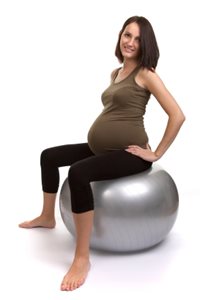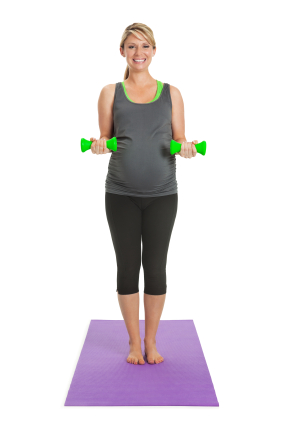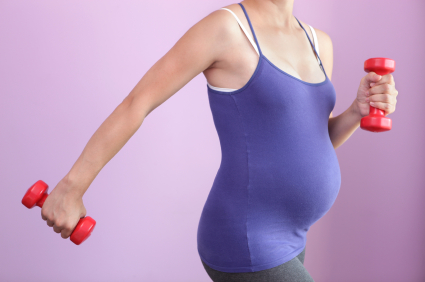Modifying Exercise During Pregnancy – The How and The Why

There is no question about it – research has consistently shown that exercising during pregnancy has multiple health benefits for both the mother and the unborn baby. However, every pregnant woman has a different journey and different challenges, and one size does not fit all when it comes to choosing and modifying an exercise program. A medical all clear from the professional who is monitoring your pregnancy is essential before exercising, and restrictions may need to be put in place for things like a low lying placenta, or high blood pressure.
Assuming that you’re given the medical all clear to exercise, let’s talk about how you can modify what you love so that you can continue to keep fit in a safe way. And, even more importantly, let’s talk about WHY these modifications are necessary. By knowing whether a modification is recommended because of potential danger to the baby, or because of potential harm to you as the mother, can empower you to choose how you exercise.
Firstly, here are three exercise modifications that are recommended to avoid negative affects to your unborn baby, and how to safely modify them.
Exercise Causing Excessive Load on the Cardiovascular System
During pregnancy, the mother’s heart has to pump blood (containing all-important oxygen and nutrients) to two bodies instead of one. This is an extra ‘physiological load’, which even from very early in pregnancy can lead to the mother feeling more breathless at low levels of exercise, and feeling faint due to low blood pressure or low blood sugar levels. As the baby grows, all the abdominal contents are pushed upwards, creating an additional ‘physical load’ on the mother’s heart and lungs. This can also lead to feelings of breathlessness and light headedness, and can cause detrimental decreases in blood flow to the mother and the baby.
Exercise changes need to be considered due these extra loads on the cardiovascular systems.
Firstly, pregnant women need to ensure that they exercise at an appropriate intensity so that their body can still provide enough oxygen to their baby. In general, it has been found that monitoring heart rate in pregnancy is not a very accurate reflection of the blood flow to the baby. Instead, it is recommended to use a ‘Rate of Perceived Exertion’, and to not get above the level of 14 out of 20. In real terms, this usually means exercising at a level where you could still hold a conversation (but not necessarily still be able to sing!).
Secondly, you may have heard about not exercising while lying flat on your back, because it can cause ‘Supine Hypotension’. This is a decrease in blood pressure and a potential decrease in blood flow to the baby due the weight of the pregnant belly putting pressure on an important blood vessel near the heart called the Inferior Vena Cava. When this vein is compressed, it can cause the mother to feel dizzy and light-headed, and could be causing a decrease in blood and oxygen to the baby. Therefore, it is recommended from about 16 - 18 weeks of pregnancy onwards, to modify any exercise lying on your back to a semi-recumbent position, and keep the abdomen lower than the chest when getting your heart rate up.
Lastly, straining and breath holding should be avoided during exercise in pregnancy. This is referred to as a ‘Valsalva Maneuver’ and usually would happen when people are lifting, pushing or pulling very heavy loads. The reason that this affects the cardiovascular system is because it greatly increases the pressure on the uterus and can cause a drop in blood flow to the baby. Therefore, decreasing the weight and increasing the repetitions during resistance exercises can ensure that the pregnant woman is exercising at a level where the blood flow to the uterus is not compromised.
 Exercise Causing Overheating
Exercise Causing Overheating
Core temperature increases in a pregnant woman of more than 1.5 degrees can be dangerous to the unborn baby. This is mainly an issue in the first trimester, when important developments in the baby’s neural system require the mother’s core temperature to stay within normal limits.
Research has shown that these core temperature changes usually occur only in very extreme circumstances, like very hot saunas and spas. However, exercise should be modified to ensure that there is always good airflow and ventilation, regular rests are able to be taken, and the pregnant woman never feels that she is overheating. Bikram yoga, cardio gym classes in enclosed indoor spaces, and hydrotherapy pools are things to consider the safety of – although it has been shown with recent research that moderate intensity exercise in pools up to 33 degrees Celsius (most hydrotherapy pools are between 31-33 degrees) is very safe for the mother and baby and did not cause an excessive increase in core muscle temperature.
Exercises Involving Danger of a Force to the Abdomen
Before about 15-20 weeks of pregnancy, the womb is tucked down low in the abdomen and the baby is protected by the pelvic bones. After this time, when the baby is above the pelvic brim, although small forces to the abdomen can be well absorbed by the fluid around the baby, excessive forces could harm the unborn baby. For this reason, it is recommended to avoid ball sports, contact sports, and exercises with a risk of falling (such as box jumps, trampolining, gymnastics etc).
Once you understand the exercise modifications that you need to make to keep the baby safe during pregnancy, the next thing is to be well informed about the modifications that are recommended for your own health. These are things that can prevent you from experiencing common issues to do with your joints, muscles, connective tissue and organs during and after pregnancy.
Exercises Putting Strain on the Pelvic Floor Muscles
The pelvic floor is an extremely important group of muscles and connective tissue that literally makes up the floor of your pelvis. It is responsible for keeping our bladder and bowel from leaking, supporting our pelvic organs to prevent vaginal prolapse, supporting our lower back and pelvic joints, and helping to keep sexual intercourse enjoyable.
Pregnancy can stretch and weaken the pelvic floor in two ways – it can be from the physical load of the weight of the growing baby and uterus, and it can also be from the physiological relaxing of the muscles and ligaments due to the pregnancy hormone relaxin, which makes the area more flexible for childbirth. A vaginal birth can then stretch and potentially injure the pelvic floor muscles further.
You can exercise these muscles to keep them strong and functioning well. However, some types of exercise can repetitively increase pressure on this already challenged muscle, and this could increase your risk of pelvic floor muscle weakness (and associated bladder or bowel leakage, vaginal prolapse etc). The types of exercise that could increase load on that area would be:
-
High impact exercise like running, jumping, skipping
-
Abdominal muscle exercises such as crunches, planks, pull ups and Russian Twists
-
Heavy weight training
While these exercises are not in the category of those that could harm the baby, it is worth considering the pros and cons of continuing exercises that would put extra pressure on an area that is already at risk of damage. It could be helpful to your pelvic floor to keep exercise low impact and low load during pregnancy (or at least during the second and third trimesters as the baby’s weight increases), and could improve the recovery of these muscles after birth.

Exercises That Could Exacerbate Abdominal Muscle Separation
No doubt you’ve heard about abdominal muscle separation, more correctly termed Rectus Abdominis Diastasis (RAD) during and after pregnancy, and you’re wondering how to avoid it. The reality is, however, that every woman who reaches full term in her pregnancy will need her six pack abdominal muscles to stretch apart from each other in the midline, otherwise there wouldn’t be enough space for the baby to grow.
While RAD is normal and a necessary adaptation during pregnancy, what needs to be realized is that this adaptation means that in the midline of a pregnant belly there is only thin connective tissue rather than thick muscles, and also that the stretching and separation means that the six pack muscle is at a big mechanical disadvantage and can’t work as efficiently as usual. Strain through the separated muscles, especially when it causes ‘doming’ or ‘coning’ when the midline bulges outwards, could set you up for abdominal hernias, back pain and difficulty training the six pack muscles to return to their normal state after you give birth.
So what impact does this have on exercise in pregnancy, and how should you modify your program to avoid putting strain through the weakened tissue in the midline of your pregnant belly? It is recommended that after the muscles start to separate, which is usually around 16-20 weeks, you should avoid exercises that use the six pack muscle, and to monitor whether any exercises cause that typical ‘doming’ that would indicate strain. This usually would occur with sit ups, planks, pull ups, muscle ups, Russian Twists and other similar exercises.
This doesn’t mean that you can’t do abdominal muscle exercises, you just need to talk to a qualified physiotherapist or fitness professional about what type of core muscle exercises (usually ones that target the deeper layers of abdominal muscles) that you can do without ‘doming’.
Exercises That Could Cause Pelvic Joint Pain and Dysfunction
Relaxin is an amazing hormone released by the pregnant body, which enables your connective tissue to be more stretchy. This occurs mainly in the pelvis in preparation for a vaginal birth, but can also occur in other body joints too.
We have three ‘pelvic girdle’ joints – the pubic symphysis joint at the front of your pelvis, and the two sacroiliac joints on either side of the back of your pelvis, where your pelvis joins to the lower spine. Pain in one or more of these joints occurs in up to half of pregnant women, and usually occurs when the joints are loaded when you put weight down through one leg, like with getting out of the car, or getting up from the floor. Usually it will occur as a sharp, sudden pain, and/or a clicking sensation, at the front or back of the pelvis.
If you experience pain like this, it is important to get it assessed by a physiotherapist who specialises in pregnancy, as it can get progressively worse without good management. You should also modify your exercise program so that you avoid single-leg-loaded activities like lunges, step ups and running.
Pregnant women may wish to pre-emptively avoid these single-leg-loaded exercises to avoid stress through potentially vulnerable joints. There are many variations of these exercises that involve weight bearing through both legs together, or having a smaller base of support, which may decrease the risk of experiencing pelvic girdle pain.
So, in summary, these modifications in this section are recommended to avoid common joint, muscle and connective tissue problems in the pregnant woman. It is important to note that if you choose to still participate in high impact exercise, or do abdominal muscle exercises during pregnancy, the research has not shown any link to this and any harm to the unborn baby.
This article has been kindly provided and written by Taryn Watson, Women's Health and Continence Physiotherapist and Founder of FitRight.